Nordus
Stylianos Chatzimanolis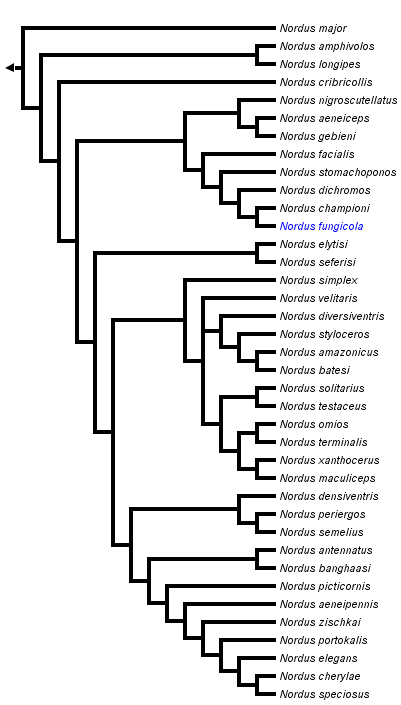


This tree diagram shows the relationships between several groups of organisms.
The root of the current tree connects the organisms featured in this tree to their containing group and the rest of the Tree of Life. The basal branching point in the tree represents the ancestor of the other groups in the tree. This ancestor diversified over time into several descendent subgroups, which are represented as internal nodes and terminal taxa to the right.

You can click on the root to travel down the Tree of Life all the way to the root of all Life, and you can click on the names of descendent subgroups to travel up the Tree of Life all the way to individual species.
For more information on ToL tree formatting, please see Interpreting the Tree or Classification. To learn more about phylogenetic trees, please visit our Phylogenetic Biology pages.
close boxIntroduction
The genus Nordus Blackwelder, 1952, contains 38 species and was recently revised by Chatzimanolis (2004). Nordus is distributed from southern Mexico to northern Argentina, with the highest diversity of species in South America and especially in Ecuador, Peru and Bolivia. These beetles range in size from 7 to 13 mm, and most species are brightly colored. The genus was originally proposed by Nordmann in 1837 as the genus Brachydirus.
Characteristics
There are several different color patterns in Nordus; most species have (probably aposematic) golden-orange coloration on the head, pronotum and elytra. Other species have the pronotum and elytra golden-orange, and the head anteriorly black and posteriorly orange, or head, pronotum and elytra are black; while one species, N. speciosus, has the head, pronotum and elytra metallic green. Among all genera in Xanthopygina, Nordus exhibits probably the most dramatic structural modifications in secondary sexual characters (on abdominal sterna VII, VIII and IX) and in the colouration of different species. The color of the abdomen is always black (except in N. portokalis, where it is orange) with a bright yellow apex (part of segment VII and segment VIII).
Nordus can be distinguished from other xanthopygines by the combination of the following structures:
- large prominent eyes;
- head with large, dense and continuous punctures, with no micropunctures;
- anteclypeus greatly reduced;
- antennae short;
- antennal articles 5-10 rounded; antennal articles 7-10 not appearing “serrate” (anterior and posterior margins of article subequal in length);
- pronotum without uniform pattern of punctation (except in N. major), with large punctures;
- abdominal terga III-VII with variable setation, setation not uniformly distributed as in most xanthopygines;
- prominent modifications of the 7th and 8th abdominal sterna in males;
- middle and hind tarsomeres 2-4 dilated and ventrally lobed.

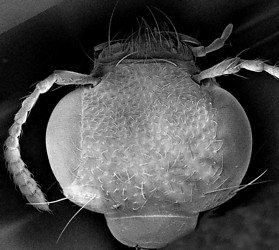

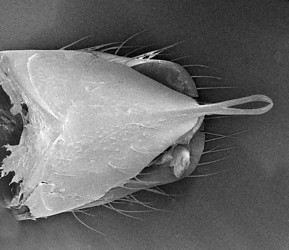
From left to right, head of N. simplex showing the punctuation pattern; VIII abdominal stergum of N. terminalis and N. styloceros respectively, showing the secondary sexual structures on this segment. Images © 2003 Stylianos Chatzimanoli.
Discussion of Phylogenetic Relationships
The tree shown above is the strict consensus of four trees. The sister-group relationships of most species are supported by multiple synapomorphies and high Bremer support values. Nordus major is sister to all remaining Nordus species. The overall shape of the head, which exhibits great allometric variation in proportion to the size of the pronotum, resembles the overall shape of the head in species of the genus Xanthopygus. This species, of course, clearly is a member of Nordus because it has all the above mentioned synapomorphies, but probably it has retained the plesiomorphic general shape of the head.
The phylogeny shows that the probably aposematic golden-orange coloration evolved in the ancestor of Nordus, although it is not clear whether this happened in the immediate ancestor of Nordus, or is shared with other genera because the phylogenetic relationships among xanthopygines are unknown.
References
Chatzimanolis S. 2004. A revision of the neotropical genus Nordus (Coleoptera: Staphylinidae). Ent. Ab. 62(1):3-64.
Chatzimanolis S. 2005. Phylogeny of the neotropical rove beetle genus Nordus (Coleoptera: Staphylinidae) with a special reference to the evolution of coloration and secondary sexual characters. Sys. Ent. 30:267-280.
Title Illustrations

| Scientific Name | Nordus velitaris |
|---|---|
| Specimen Condition | Dead Specimen |
| Identified By | Stylianos Chatzimanolis |
| Image Use |
 This media file is licensed under the Creative Commons Attribution-NonCommercial License - Version 3.0. This media file is licensed under the Creative Commons Attribution-NonCommercial License - Version 3.0.
|
| Copyright |
© Stylianos Chatzimanolis

|
| Scientific Name | Nordus fungicola |
|---|---|
| Location | Barro Colorado Island, Panama |
| Specimen Condition | Live Specimen |
| Identified By | Stylianos Chatzimanolis |
| Image Use |
 This media file is licensed under the Creative Commons Attribution-NonCommercial License - Version 3.0. This media file is licensed under the Creative Commons Attribution-NonCommercial License - Version 3.0.
|
| Copyright |
© Stylianos Chatzimanolis

|
| Scientific Name | Nordus speciosus |
|---|---|
| Specimen Condition | Dead Specimen |
| Identified By | Stylianos Chatzimanolis |
| Image Use |
 This media file is licensed under the Creative Commons Attribution-NonCommercial License - Version 3.0. This media file is licensed under the Creative Commons Attribution-NonCommercial License - Version 3.0.
|
| Copyright |
© Stylianos Chatzimanolis

|
About This Page
Stylianos Chatzimanolis

University of Tennessee at Chattanooga
Correspondence regarding this page should be directed to Stylianos Chatzimanolis at
Page copyright © 2005 Stylianos Chatzimanolis
 Page: Tree of Life
Nordus.
Authored by
Stylianos Chatzimanolis.
The TEXT of this page is licensed under the
Creative Commons Attribution License - Version 3.0. Note that images and other media
featured on this page are each governed by their own license, and they may or may not be available
for reuse. Click on an image or a media link to access the media data window, which provides the
relevant licensing information. For the general terms and conditions of ToL material reuse and
redistribution, please see the Tree of Life Copyright
Policies.
Page: Tree of Life
Nordus.
Authored by
Stylianos Chatzimanolis.
The TEXT of this page is licensed under the
Creative Commons Attribution License - Version 3.0. Note that images and other media
featured on this page are each governed by their own license, and they may or may not be available
for reuse. Click on an image or a media link to access the media data window, which provides the
relevant licensing information. For the general terms and conditions of ToL material reuse and
redistribution, please see the Tree of Life Copyright
Policies.
- First online 18 December 2005
Citing this page:
Chatzimanolis, Stylianos. 2005. Nordus. Version 18 December 2005. http://tolweb.org/Nordus/10274/2005.12.18 in The Tree of Life Web Project, http://tolweb.org/





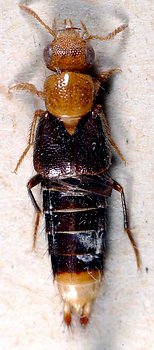
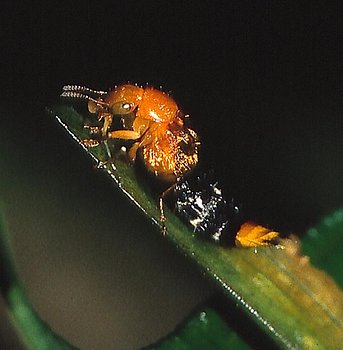
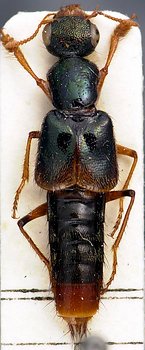




 Go to quick links
Go to quick search
Go to navigation for this section of the ToL site
Go to detailed links for the ToL site
Go to quick links
Go to quick search
Go to navigation for this section of the ToL site
Go to detailed links for the ToL site